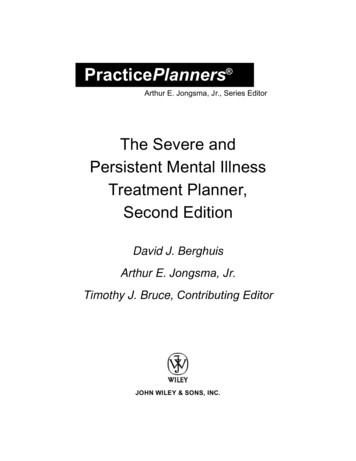
Transcription
PracticePlanners Arthur E. Jongsma, Jr., Series EditorThe Severe andPersistent Mental IllnessTreatment Planner,Second EditionDavid J. BerghuisArthur E. Jongsma, Jr.Timothy J. Bruce, Contributing EditorJOHN WILEY & SONS, INC.
The Severe andPersistent Mental IllnessTreatment Planner,Second Edition
PracticePlanners SeriesTreatment eTheComplete Adult Psychotherapy Treatment Planner, Fourth EditionChild Psychotherapy Treatment Planner, Fourth EditionAdolescent Psychotherapy Treatment Planner, Fourth EditionAddiction Treatment Planner, Third EditionContinuum of Care Treatment PlannerCouples Psychotherapy Treatment PlannerEmployee Assistance Treatment PlannerPastoral Counseling Treatment PlannerOlder Adult Psychotherapy Treatment PlannerBehavioral Medicine Treatment PlannerGroup Therapy Treatment PlannerGay and Lesbian Psychotherapy Treatment PlannerFamily Therapy Treatment PlannerSevere and Persistent Mental Illness Treatment Planner, Second EditionMental Retardation and Developmental Disability Treatment PlannerSocial Work and Human Services Treatment PlannerCrisis Counseling and Traumatic Events Treatment PlannerPersonality Disorders Treatment PlannerRehabilitation Psychology Treatment PlannerSpecial Education Treatment PlannerJuvenile Justice and Residential Care Treatment PlannerSchool Counseling and School Social Work Treatment PlannerSexual Abuse Victim and Sexual Offender Treatment PlannerProbation and Parole Treatment PlannerPsychopharmacology Treatment PlannerSpeech-Language Pathology Treatment PlannerSuicide and Homicide Treatment PlannerCollege Student Counseling Treatment PlannerParenting Skills Treatment PlannerEarly Childhood Intervention Treatment PlannerCo-Occurring Disorders Treatment PlannerComplete Women’s Psychotherapy Treatment PlannerProgress Notes PlannersTheTheTheTheTheTheTheChild Psychotherapy Progress Notes Planner, Third EditionAdolescent Psychotherapy Progress Notes Planner, Third EditionAdult Psychotherapy Progress Notes Planner, Third EditionAddiction Progress Notes Planner, Second EditionSevere and Persistent Mental Illness Progress Notes Planner, Second EditionCouples Psychotherapy Progress Notes PlannerFamily Therapy Progress Notes PlannerHomework PlannersBrief Couples Therapy Homework PlannerBrief Employee Assistance Homework PlannerBrief Family Therapy Homework PlannerGrief Counseling Homework PlannerGroup Therapy Homework PlannerDivorce Counseling Homework PlannerSchool Counseling and School Social Work Homework PlannerChild Therapy Activity and Homework PlannerAddiction Treatment Homework Planner, Third EditionAdolescent Psychotherapy Homework Planner IIAdolescent Psychotherapy Homework Planner, Second EditionAdult Psychotherapy Homework Planner, Second EditionChild Psychotherapy Homework Planner, Second EditionParenting Skills Homework PlannerClient Education Handout PlannersAdult Client Education Handout PlannerChild and Adolescent Client Education Handout PlannerCouples and Family Client Education Handout PlannerComplete PlannersThe Complete Depression Treatment and Homework PlannerThe Complete Anxiety Treatment and Homework Planner
PracticePlanners Arthur E. Jongsma, Jr., Series EditorThe Severe andPersistent Mental IllnessTreatment Planner,Second EditionDavid J. BerghuisArthur E. Jongsma, Jr.Timothy J. Bruce, Contributing EditorJOHN WILEY & SONS, INC.
This book is printed on acid-free paper.Copyright 2008 by David J. Berghuis and Arthur E. Jongsma, Jr. All rights reserved.Published by John Wiley & Sons, Inc., Hoboken, New Jersey.Published simultaneously in Canada.No part of this publication may be reproduced, stored in a retrieval system, or transmitted in any form orby any means, electronic, mechanical, photocopying, recording, scanning, or otherwise, except as permitted under Section 107 or 108 of the 1976 United States Copyright Act, without either the prior writtenpermission of the Publisher, or authorization through payment of the appropriate per-copy fee to theCopyright Clearance Center, Inc., 222 Rosewood Drive, Danvers, MA 01923, (978) 750-8400, fax (978)646-8600, or on the web at www.copyright.com. Requests to the Publisher for permission should beaddressed to the Permissions Department, John Wiley & Sons, Inc., 111 River Street, Hoboken, NJ07030, (201) 748-6011, fax (201) 748-6008, or online at http://www.wiley.com/go.permissions.Limit of Liability/Disclaimer of Warranty: While the publisher and author have used their best efforts inpreparing this book, they make no representations or warranties with respect to the accuracy or completeness of the contents of this book and specifically disclaim any implied warranties of merchantabilityor fitness for a particular purpose. No warranty may be created or extended by sales representatives orwritten sales materials. The advice and strategies contained herein may not be suitable for your situation.You should consult with a professional where appropriate. Neither the publisher nor author shall be liablefor any loss of profit or any other commercial damages, including but not limited to special, incidental,consequential, or other damages.This publication is designed to provide accurate and authoritative information in regard to the subjectmatter covered. It is sold with the understanding that the publisher is not engaged in rendering professional services. If legal, accounting, medical, psychological or any other expert assistance is required, theservices of a competent professional person should be sought.Designations used by companies to distinguish their products are often claimed as trademarks. In allinstances where John Wiley & Sons, Inc. is aware of a claim, the product names appear in initial capitalor all capital letters. Readers, however, should contact the appropriate companies for more completeinformation regarding trademarks and registration.All references to diagnostic codes are reprinted with permission from the Diagnostic and StatisticalManual of Mental Disorders, Fourth Edition, Text Revision. Copyright 2000. American Psychiatric Association.For general information on our other products and services please contact our Customer Care Department within the U.S. at (800) 762-2974, outside the United States at (317) 572-3993 or fax (317) 5724002.Wiley also publishes its books in a variety of electronic formats. Some content that appears in printmay not be available in electronic books. For more information about Wiley products, visit our website at www.wiley.com.ISBN-13: 978-0-470-18013-6Printed in the United States of America.10987654321
To my wife, Barbara, for whom my love grows every day, and to my children,Katherine and Michael, who make me proud.—David J. BerghuisTo Tom Van Wylen and Mary Boll, two friends who have stepped forward toshow their support for those who work with clients struggling with severe andpersistent mental illness. Thank you and God bless you.—Arthur E. Jongsma, Jr.To all of those individuals who struggle with severe mental problems and to allof the individuals who dedicate their lives to helping them.—Timothy J. Bruce
CONTENTSPracticePlanners Series PrefaceAcknowledgmentsIntroductionSample Treatment Planxiiixvii18Activities of Daily Living (ADL)AgingAnger ManagementAnxietyBorderline PersonalityChemical DependenceDepressionEmployment ProblemsFamily ConflictsFinancial NeedsGrief and LossHealth IssuesHomelessnessIndependent Activities of Daily Living (IADL)Intimate Relationship ConflictsLegal ConcernsMania or HypomaniaMedication ManagementObsessive-Compulsive Disorder 94100107114124133141150157164173indicates that the Objective/Intervention is consistent with those found in evidence-basedtreatments.xi
xiiCONTENTSParentingPosttraumatic Stress Disorder (PTSD)PsychosisRecreational DeficitsSelf-Determination DeficitsSexuality ConcernsSocial AnxietySocial Skills DeficitsSpecific Fears and AvoidanceSuicidal Ideation181190200208216226235243251259Appendix A: Bibliotherapy SuggestionsAppendix B: References for Evidence-Based ChaptersAppendix C: Index of DSM-IV-TR CodesAssociated with Presenting Problems269285305
PRACTICEPLANNERS SERIES PREFACEAccountability is an important dimension of the practice of psychotherapy.Treatment programs, public agencies, clinics, and practitioners must justify anddocument their treatment plans to outside review entities in order to be reimbursed for services. The books and software in the PracticePlanners series aredesigned to help practitioners fulfill these documentation requirements efficientlyand professionally.The PracticePlanners series includes a wide array of treatment-planningbooks, including not only the original Complete Adult Psychotherapy TreatmentPlanner, Child Psychotherapy Treatment Planner, and Adolescent Psychotherapy Treatment Planner, all now in their fourth editions, but also Treatment Planners targeted to a wide range of specialty areas of practice, including: AddictionsBehavioral medicineCollege studentsCo-occurring disordersCouples therapyCrisis counselingEarly childhood educationEmployee assistanceFamily therapyGays and lesbiansGroup therapyJuvenile justice and residential careMental retardation and developmental disabilityNeuropsychologyOlder adultsParenting skillsPastoral counselingxiii
xivPRACTICEPLANNERS SERIES PREFACE Personality disordersProbation and parolePsychopharmacologySchool counselingSevere and persistent mental illnessSexual abuse victims and offendersSpecial educationSuicide and homicide risk assessmentWomen’s issuesIn addition, there are three branches of companion books that can be used in conjunction with the Treatment Planners, or on their own: Progress Notes Planners provide a menu of progress statements thatelaborate on the client’s symptom presentation and the provider’stherapeutic intervention. Each Progress Notes Planner statement isdirectly integrated with the behavioral definitions and therapeutic interventions from its companion Treatment Planner. Homework Planners include homework assignments designedaround each presenting problem (e.g., anxiety, depression, chemicaldependence, anger management, eating disorders, or panic disorder)that is the focus of a chapter in its corresponding Treatment Planner. Client Education Handout Planners provide brochures and handoutsto help educate and inform clients on presenting problems and mentalhealth issues, as well as life skills techniques. The handouts are included on CD-ROMs for easy printing from your computer and areideal for use in waiting rooms, at presentations, as newsletters, or asinformation for clients struggling with mental illness issues. The topics covered by these handouts correspond to the presenting problemsin the Treatment Planners.The series also includes: TheraScribe , the best-selling treatment-planning and clinical recordkeeping software system for mental health professionals. TheraScribe allows the user to import the data from any of the Treatment Planner,Progress Notes Planner, or Homework Planner books into the software’s expandable database to simply point and click to create a detailed, organized, individualized, and customized treatment plan alongwith optional integrated progress notes and homework assignments.
PRACTICEPLANNERS SERIES PREFACExvAdjunctive books, such as The Psychotherapy Documentation Primer andThe Clinical Documentation Sourcebook contain forms and resources to aid theclinician in mental health practice management.The goal of our series is to provide practitioners with the resources they needin order to provide high-quality care in the era of accountability. To put it simply:We seek to help you spend more time on patients and less time on paperwork.ARTHUR E. JONGSMA JR.Grand Rapids, Michigan
ACKNOWLEDGMENTSA variety of people should be acknowledged for their assistance in developingthis Planner. First, the clients who have been willing to share their lives and troubles have taught us more than can be written. Several staff members of theCommunity Mental Health Centers in Ionia County and Newaygo County (bothin Michigan) have either knowingly or unknowingly provided feedback and ideasthroughout the unfolding of this project. While developing the first edition of thisPlanner, the authors were also involved in the writing of The Mental Retardationand Developmental Disability Treatment Planner, with Kellye Slaggert. Manyideas developed for that Planner were adapted for this one. Barbara Berghuis,wife of the primary author, and a case manager herself, was instrumental in developing and critiquing the manuscript throughout the process. The library staffof Calvin College and Seminary were invaluable in their assistance while researching material for this project.This second edition has been improved beyond measure by the guidance andcontribution of Dr. Tim Bruce. He has been our well-informed expert on the evidence-based content that exists in the professional literature. Thank you, Tim.Sue Rhoda, our manuscript manager, has been a wonderful assistant who hasvery efficiently kept all the details organized, allowing us to submit a final product that has been polished by her professional hand. Thank you, Sue.No project this large gets completed without other priorities being rearranged. The willingness of our families to allow us to take the time to bring thisidea to fruition is very much appreciated. It is their support and guidance thathave allowed us to help others. The editorial staff at John Wiley & Sons has consistently provided us with supremely competent encouragement and guidance forwhich we are grateful.A. E. J.D. J. B.xvii
The Severe andPersistent Mental IllnessTreatment Planner,Second Edition
INTRODUCTIONABOUT PRACTICEPLANNERS TREATMENT PLANNERSPressure from third-party payors, accrediting agencies, and other outside parties has increased the need for clinicians to quickly produce effective, highquality treatment plans. Treatment Planners provide all the elements necessary to quickly and easily develop formal treatment plans that satisfy theneeds of most third-party payors and state and federal review agencies.Each Treatment Planner: Saves you hours of time-consuming paperwork.Offers the freedom to develop customized treatment plans.Includes over 1,000 clear statements describing the behavioral manifestations of each relational problem, and includes long-term goals, short-termobjectives, and clinically tested treatment options.Has an easy-to-use reference format that helps locate treatment plancomponents by behavioral problem or DSM-IV diagnosis.As with the rest of the books in the PracticePlanners series, our aim is toclarify, simplify, and accelerate the treatment planning process, so you spendless time on paperwork, and more time with your clients.ABOUT THE SEVERE AND PERSISTENT MENTALILLNESS TREATMENT PLANNERThe field of treatment for the severely and persistently mentally ill is at a pivotal point in its evolution. New medications have provided stability to peoplewho have been chronically unstable in the past. What started with deinstitutionalization and the growth of community mental health centers has gradually transformed into a myriad of agencies and clinicians who providetreatment in a variety of settings. Many changes have also occurred for theagencies serving this population. In many areas, the service providers have1
2THE SEVERE AND PERSISTENT MENTAL ILLNESS TREATMENT PLANNERbeen compelled to become more efficient and competitive for their clientele.Most agencies are required to obtain accreditation from outside auditors, suchas the Joint Commission on the Accreditation of Health Organizations(JCAHO), Council on Accreditation (COA), or the Commission on Accreditation of Rehabilitation Facilities (CARF). Payors often demand documentationof positive outcomes for clients whom we serve. With these many changes inthe field, the need for better organization, treatment techniques, and documentation becomes self-evident.To fill this need, we have developed The Severe and Persistent MentalIllness Treatment Planner. This Planner suggests thousands of prewritten behavioral definitions, objectives, goals, and interventions for a variety of problem areas experienced by the men and women who suffer from chronicmental illness. This book will be useful to any clinician working with thispopulation, but care has been taken to write from the perspective of the clinician who manages the client’s entire treatment, whether he or she be called acase manager, supports coordinator, social worker, or some other name.Goals and interventions are written for a variety of types and levels of intensity of severe and persistent mental illnesses. It is our hope that this Plannerwill allow clinicians to quickly and accurately develop and implement helpfultreatment plans for their clients. In this second edition, we have made thechapters more focused and, in many cases, shorter. We have also added a fewnew chapters. But the most significant change for this edition is the additionof evidence-based Objectives and Interventions to those chapters where research data is available to inform the content.INCORPORATING EVIDENCE-BASED TREATMENT (EBT)Evidence-based treatment (that is, treatment that is scientifically shown in research trials to be efficacious) is rapidly becoming critically important to themental health community because insurance companies are beginning to offer preferential pay to organizations using it. In fact, the APA Division 12(Society of Clinical Psychology) lists of empirically supported treatmentshave been referenced by a number of local, state, and federal funding agencies, which are beginning to restrict reimbursement to these treatments, as aresome managed care and insurance companies.In this second edition of The Severe and Persistent Mental Illness Treatment Planner, we have made an effort to empirically inform some chaptersby highlighting short-term objectives (STOs) and therapeutic interventions(TIs) that are consistent with psychological treatments or therapeutic programs that have demonstrated some level of efficacy through empirical study.Watch for this iconas an indication that an Objective/Intervention is consistent with those found in evidence-based treatments.
INTRODUCTION3References to their empirical support have been included in Appendix B.For information related to the identification of evidence-based practices(EBPs), including the benefits and limitations of the effort, we suggest Bruceand Sanderson (2005); Chambless et. al. (1996, 1998); Chambless and Ollendick (2001); Drake, Merrens, and Lynde (2005); Hofmann and Tompson(2002); Nathan and Gorman (2002); and Stout and Hayes (2005).In this Planner, we have included STOs and TIs consistent with EBPs thatare more programmatic than psychotherapeutic in nature and that have beenfound efficacious for problems common to those struggling with severe andpersistent mental illnesses (SPMIs). Examples include supported employmentand family psychoeducation. We have also included STOs and TIs reflective ofpsychotherapeutic approaches that have shown efficacy for disorders typicallysubsumed under the SPMI rubric (e.g., interpersonal therapy for depression,cognitive behavior therapy for psychotic features). In addition, we includedSTOs and TIs reflective of treatments that been found efficacious for problemsnot commonly characterized as SPMIs (e.g., obsessive compulsive disorder,panic disorder, social anxiety), but that nonetheless present clinically on occasion, have an evidence base within the populations studied, and that therapistsmay adapt for use with clients who struggle with these problems. Beyond references to the empirical studies supporting these interventions, we have provided references to therapist- and client-oriented books and treatment manualsthat describe the use of identified EBPs or treatments consistent with their objectives and interventions. Recognizing that there are STOs and TIs that practicing clinicians have found useful but that have not yet received empiricalscrutiny, we have included those that reflect common best practice among experienced clinicians. The goal is to provide a range of treatment plan options,some studied empirically, others reflecting common clinical practice, so theusers can construct what they believe to be the best plan for a particular client.In some instances, the EBPs referenced are short-term, problem-orientedtreatments that focus on improving current specific problems or symptomsrelated to a client’s current distress and disability. For those, STOs and TIsreflective of the EBP have been placed earlier in the sequence of STO and TIoptions. In addition, some STOs and TIs reflect core components of the EBPapproach that are always delivered (e.g., exposure to feared objects and situations for a phobic disorders; behavioral activation for depression). Others reflect adjuncts to treatment that may or may not be used all the time (e.g.,social and other communication skills, stress management skills). For theEBPs that are more programmatic in nature, such as supported employment,the STOs and TIs are consistent with the types of competencies in which professionals who deliver these inventions are trained. Most of the STOs and TIsassociated with the EBPs are described at a level of detail that permits flexibility and adaptability in their specific application. As with all Planners in thisseries, each chapter includes the option to add STOs and TIs at the therapist’sdiscretion.
4THE SEVERE AND PERSISTENT MENTAL ILLNESS TREATMENT PLANNERCriteria for Inclusion of Evidence-Based TherapiesThe EBPs from which STOs and TIs were taken have different levels of empirical work supporting them. Some have been well established as efficaciousfor the changes they target (e.g., supported employment). Others have lesssupport, but nonetheless have demonstrated efficacy. The EBPs for disordersnot typically classified as SPMIs, such as panic disorder and other anxietydisorders, have very strong empirical support for their efficacy, but have established that support through studies whose participants carried a primarydiagnosis of an anxiety disorder, not a SPMI. These approaches have beenincluded in this edition because some clients who struggle with SPMIs andalso struggle with these other disorders may benefit from these EBP approaches. With that in mind, however, we have included EBPs for which theempirical support has either been well established or demonstrated at morethan a preliminary level as defined by those authors who have undertaken thetask of identifying them, such as Drake and colleagues (2003, 2005), Chambless and colleagues (1996, 1998), and Nathan and Gorman (1998, 2002).At minimum, efficacy needed to be demonstrated through a clinical trialor large clinical replication series with features reflecting good experimentaldesign (e.g., random assignment, blind assignments, reliable and valid measurement, clear inclusion and exclusion criteria, state-of-the-art diagnosticmethods, and adequate sample size or replications). Well-established EBPstypically have more than one of these types of studies demonstrating theirefficacy, as well as other desirable features such as demonstration of efficacyby independent research groups and specification of client characteristics forwhich the treatment was effective.Because treatment literatures for various problems develop at differentrates, treatment STOs and TIs that have been included may have the mostempirical support for their problem area, but less than that found in moreheavily studied areas. For example, Dialectical Behavioral Therapy (DBT) hasthe highest level of empirical support of tested psychotherapies for borderlinepersonality disorder (BPD), but that level of evidence is lower than that supporting, for example, supported employment or exposure-based therapy forphobic fear and avoidance. The latter two have simply been studied moreextensively, so there are more trials, replications, and the like. Nonetheless,within the psychotherapy outcome literature for BPD, DBT clearly has thehighest level of evidence supporting its efficacy and usefulness. Accordingly,STOs and TIs consistent with DBT have been included in this edition. Last, allinterventions, empirically supported or not, must be adapted to the particularclient in light of his/her personal circumstances, strengths, and vulnerabilities.The STOs and TIs included in this Planner are written in a manner to suggestand allow this adaptability.
INTRODUCTION5Summary of Required and Preferred SPMI EBTInclusion CriteriaRequired Demonstration of efficacy through at least one randomized controlledtrial with good experimental design, or Demonstration of efficacy through a large, well-designed clinical replication series.Preferred Efficacy has been shown by more than one study. Efficacy has been demonstrated by independent research groups. Client characteristics for which the treatment was effective were specified. A clear description of the treatment was available.HOW TO USE THIS TREATMENT PLANNERUse this Treatment Planner to write treatment plans according to the following six-step progression:1. Problem Selection. Although the client may discuss a variety of issuesduring the assessment, the clinician must determine the most significantproblems on which to focus the treatment process. Usually a primaryproblem will surface, and secondary problems may also be evident. Someother problems may have to be set aside as not urgent enough to requiretreatment at this time. An effective treatment plan can only deal with afew selected problems or treatment will lose its direction. Choose theproblem within this Planner that most accurately represents your client’spresenting issues.2. Problem Definition. Each client presents with unique nuances as to how aproblem behaviorally reveals itself in his or her life. Therefore, eachproblem that is selected for treatment focus requires a specific definitionabout how it is evidenced in the particular client. The symptom patternshould be associated with diagnostic criteria and codes such as thosefound in the DSM-IV or the International Classification of Diseases. ThisPlanner offers such behaviorally specific definition statements to choosefrom or to serve as a model for your own personally crafted statements.3. Goal Development. The next step in developing your treatment plan is toset broad goals for the resolution of the target problem. These statementsneed not be crafted in measurable terms but can be global, long-termgoals that indicate a desired positive outcome to the treatment procedures.This Planner provides several possible goal statements for each problem,but one statement is all that is required in a treatment plan.
6THE SEVERE AND PERSISTENT MENTAL ILLNESS TREATMENT PLANNER4. Objective Construction. In contrast to long-term goals, objectives must bestated in behaviorally measurable language so that it is clear to reviewagencies, health maintenance organizations, and managed care organizations when the client has achieved the established objectives. The objectivespresented in this Planner are designed to meet this demand for accountability. Numerous alternatives are presented to allow construction of a varietyof treatment plan possibilities for the same presenting problem.5. Intervention Creation. Interventions are the actions of the clinician designed to help the client complete the objectives. There should be at leastone intervention for every objective. If the client does not accomplish theobjective after the initial intervention, new interventions should be addedto the plan. Interventions should be selected on the basis of the client’sneeds and the treatment provider’s full therapeutic repertoire. This Planner contains interventions from a broad range of therapeutic approaches,and we encourage the provider to write other interventions reflecting hisor her own training and experience.Some suggested interventions listed in the Planner refer to specificbooks that can be assigned to the client for adjunctive bibliotherapy. Appendix A contains a full bibliographic reference list of these materials. For further information about self-help books, mental health professionals may wishto consult The Authoritative Guide to Self-Help Resources in Mental Health,Revised Edition (New York: Guilford Press, 2003) by Norcross et al.6. Diagnosis Determination. The determination of an appropriate diagnosisis based on an evaluation of the client’s complete clinical presentation.The clinician must compare the behavioral, cognitive, emotional, and interpersonal symptoms that the client presents with the criteria for diagnosis of a mental illness condition as described in DSM-IV. Despitearguments made against diagnosing clients in this manner, diagnosis is areality that exists in the world of mental health care, and it is a necessityfor third-party reimbursement. It is the clinician’s thorough knowledge ofDSM-IV criteria and a complete understanding of the client assessmentdata that contribute to the most reliable, valid diagnosis.Congratulations! After completing these six steps, you should have a comprehensive and individualized treatment plan ready for immediate implementation and presentation to the client. A sample treatment plan for MedicationManagement is provided at the end of this introduction.A FINAL NOTE ON TAILORING THE TREATMENT PLANTO THE CLIENTOne important aspect of effective treatment planning is that each plan shouldbe tailored to the individual client’s problems and needs. Treatment plans
INTRODUCTION7should not be mass-produced, even if clients have similar problems. The individual’s strengths and weaknesses, unique stressors, social
The Child Psychotherapy Progress Notes Planner, Third Edition The Adolescent Psychotherapy Progress Notes Planner, Third Edition The Adult Psychotherapy Progress Notes Planner, Third Edition The Addiction Progress Notes Planner, Second Edition The Severe and Persistent Mental Illness Progress Notes Planner, Second Edition The Couples .










